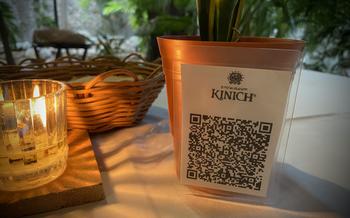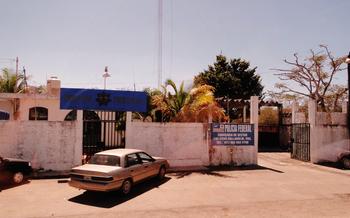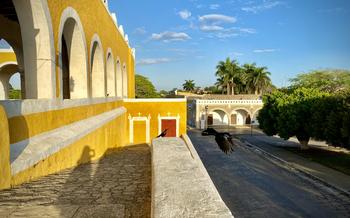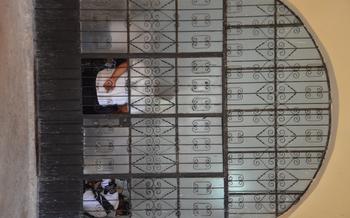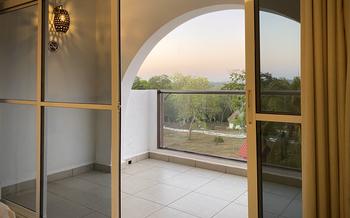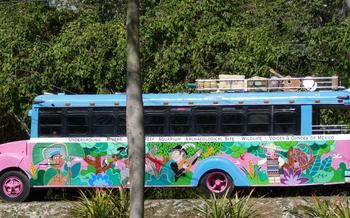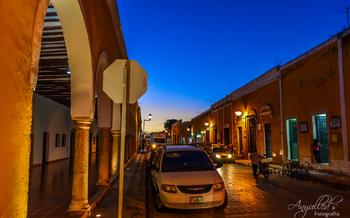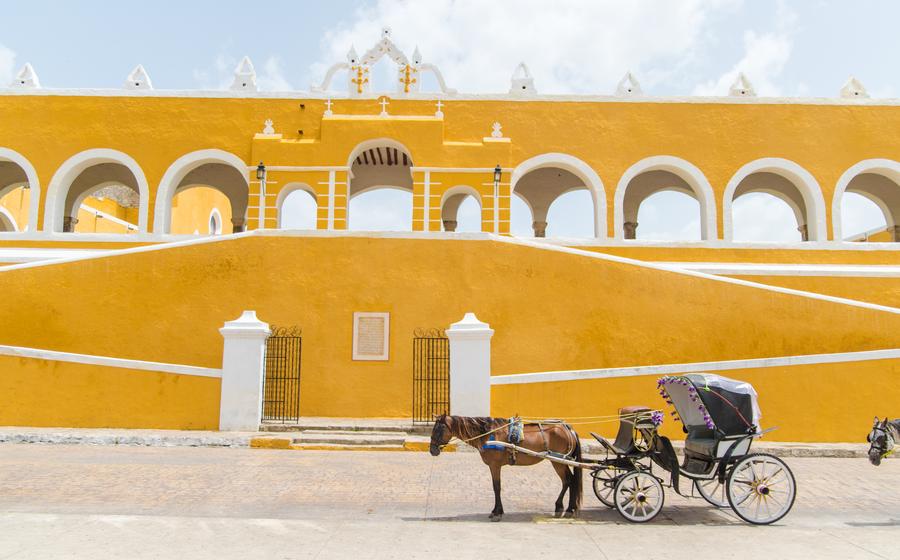
Casa de los Venados, Valladolid (Nearby city)
- A Journey to Izamal: Unveiling the Magic of the Yellow City
- Exploring the Casa de los Venados: A Cultural Treasure Trove
- Stepping into the Past at the Convent of San Antonio de Padua
- Unveiling the Mysteries of the Pyramid of Kinich Kakmó
- Strolling along the Calzada de los Frailes: A Path of History
- Discovering the Cenote Suytun: A Natural Wonder
- Savoring the Flavors of Izamal: A Culinary Adventure
- A Glimpse into the Handicraft Traditions of Izamal
- Participating in the Traditional Vaquerías: A Cultural Extravaganza
- Day Trip to Valladolid: Exploring a Colonial Gem
- Strolling through the Colorful Streets of Valladolid
- Indulging in the Gastronomic Delights of Valladolid
- Unveiling the Secrets of Ek Balam: An Ancient Mayan City
- Insider Tip: Discovering Hidden Gems Off the Beaten Path
A Journey to Izamal: Unveiling the Magic of the Yellow City
Nestled in the heart of Mexico's Yucatán Peninsula, Izamal stands as a testament to the rich history and vibrant culture of the region. Once a significant Mayan city, Izamal was conquered by the Spanish in the 16th century, leaving behind a captivating blend of indigenous and colonial influences.
The city's most striking feature is its uniform yellow hue, a result of a local legend that claims the entire town was painted yellow to welcome Pope John Paul II during his visit in 199This unique architectural characteristic has earned Izamal the nickname "Ciudad Amarilla" (Yellow City), adding to its allure and charm.
As you wander through Izamal's cobblestone streets, you'll be greeted by the warm smiles of locals and enveloped in the city's tranquil atmosphere. Prepare to be captivated by the harmonious fusion of Mayan and Spanish traditions, making Izamal a must-visit destination for those seeking an authentic Mexican experience.
Exploring the Casa de los Venados: A Cultural Treasure Trove
Step into the enchanting world of the Casa de los Venados, a captivating museum nestled in the heart of Izamal. This architectural gem was once a private residence before being transformed into a cultural haven, showcasing an extraordinary collection of Mexican folk art. As you wander through its vibrant halls, prepare to be captivated by the diverse and exquisite displays that celebrate the rich traditions of Mexico's indigenous communities.
The museum's founder, Don Jorge Carlos Hurtado, was a passionate collector who dedicated his life to preserving and promoting Mexican folk art. His discerning eye and deep appreciation for traditional craftsmanship are evident in every corner of the Casa de los Venados. From intricate textiles and colorful pottery to hand-carved wooden sculptures and gleaming silverwork, the museum's collection is a testament to the enduring creativity and artistry of Mexico's indigenous peoples.
Don't miss the opportunity to join one of the guided tours offered by the museum. Knowledgeable guides will lead you through the galleries, sharing fascinating stories and insights about the artworks and the cultures they represent. You'll gain a deeper understanding of the symbolism, techniques, and beliefs that have shaped these remarkable creations.
The Casa de los Venados also offers a variety of workshops and classes, allowing visitors to immerse themselves in the art of Mexico. Learn the ancient techniques of weaving, pottery, or embroidery, and create your own unique souvenirs to cherish. These hands-on experiences provide a deeper connection to the traditions and skills that have been passed down through generations.
Stepping into the Past at the Convent of San Antonio de Padua
The Convent and architectural grandeur. Constructed in the 16th century by Franciscan friars, the convent played a pivotal role in the evangelization of the Maya people. Its imposing facade, adorned with intricate carvings and sculptures, hints at the stories that lie within.
One of the most intriguing figures associated with the convent is Diego de Landa, a Spanish friar who arrived in Izamal in 154Landa is remembered for his controversial role in the destruction of Mayan codices, which he believed to be heretical. His actions led to the loss of invaluable knowledge about Mayan culture and history.
In a twist of fate, the convent that Landa helped to build would later become a center for the preservation and celebration of Mayan culture. After centuries of serving as a religious institution, the convent was transformed into a cultural center in the 1990s. Today, it houses a museum, an art gallery, and a library dedicated to promoting Mayan culture and heritage.
Visitors to the Convent of San Antonio de Padua can explore its beautifully restored interiors, admire the colonial-era artwork, and learn about the fascinating history of the Maya people. The convent stands as a symbol of Izamal's resilience and its commitment to preserving its cultural legacy.
Unveiling the Mysteries of the Pyramid of Kinich Kakmó
Deep within the heart of Izamal, shrouded in an aura of ancient wisdom, lies the majestic Pyramid of Kinich Kakmó. This towering structure, a testament to the ingenuity and spiritual beliefs of the Maya civilization, beckons travelers to unravel its mysteries.
Emerging from the verdant landscape, the pyramid's imposing silhouette commands attention. Its construction dates back to the Late Classic period (600-900 AD), when Izamal flourished as a prominent Maya city-state. Dedicated to Kinich Kakmó, the Maya sun god, this pyramid served as a sacred site for religious ceremonies and rituals.
Ascend the weathered steps, each imbued with the echoes of time, and reach the summit to witness a breathtaking panorama. The city of Izamal, bathed in the golden glow of the setting sun, unfolds before your eyes. Gaze upon the rooftops and spires, painted in a vibrant symphony of colors, as if mirroring the brilliance of the celestial body they worshipped.
Kinich Kakmó was not merely a place of worship; it was also a celestial observatory. The Maya, with their profound understanding of astronomy, aligned the pyramid's structure with the movements of the sun and stars. During the spring and autumn equinoxes, the pyramid casts a perfect shadow, creating a mesmerizing spectacle that echoes the Maya's reverence for the cosmos.
Immerse yourself in the mystical aura of the Pyramid of Kinich Kakmó, where history, spirituality, and natural beauty intertwine. Let its ancient stones transport you back in time, allowing you to glimpse into the profound beliefs and practices of a civilization that left an indelible mark on the world.
Strolling along the Calzada de los Frailes: A Path of History
The Calzada de los Frailes, or Monk's Causeway, is a remarkable stone path that leads from the Convent of San Antonio de Padua to the Pyramid of Kinich Kakmó. Constructed in the 16th century by Franciscan friars, this ancient pathway holds immense historical significance. As you stroll along the Calzada, you'll be captivated by the lush vegetation and serene atmosphere that surrounds you.
Along the way, you'll encounter several architectural landmarks that showcase the city's rich heritage. The Hospital de San Joaquín, built in the 18th century, stands as a testament to the philanthropic efforts of the Franciscan order. The Templo de la Purísima Concepción, a small chapel dating back to the 16th century, exudes a sense of tranquility and devotion.
As you continue your walk, the vibrant street life of Izamal unfolds before you. Local artisans display their handmade crafts, inviting you to take home a piece of the city's cultural heritage. You'll stumble upon cozy cafes and restaurants, where you can savor delicious Yucatecan cuisine and immerse yourself in the local flavors.
The Calzada de los Frailes is more than just a path; it's a living testament to Izamal's enduring spirit. Take your time to explore its every corner, soak in the atmosphere, and let the city's magic captivate you.
Discovering the Cenote Suytun: A Natural Wonder
Tucked away amidst the lush vegetation of Izamal lies a hidden gem that beckons nature enthusiasts and adventure seekers alike: the mesmerizing Cenote Suytun. This subterranean wonder is a testament to the region's rich geological history, offering a unique and refreshing experience to those who dare to venture into its depths.
Formed by the collapse of a limestone bedrock, Cenote Suytun is a sinkhole cenote, characterized by its dramatic vertical walls and crystal-clear waters. Descend into the cenote's depths, and you will be greeted by a breathtaking spectacle of stalactites and stalagmites, creating an otherworldly ambiance that will leave you spellbound.
Immerse yourself in the cenote's refreshing waters and revel in the tranquility of this natural oasis. The crystal-clear visibility allows for excellent swimming and snorkeling, where you can encounter a variety of aquatic life, including colorful fish and turtles. For those seeking a more thrilling experience, diving into the cenote's depths is a must, where you can explore underwater caves and tunnels, revealing the hidden secrets of this subterranean wonder.
Beyond its natural beauty, Cenote Suytun holds a special allure for those seeking a spiritual connection with nature. The cenote's serene atmosphere and sacred Mayan history create a mystical ambiance, making it a popular spot for meditation and spiritual rituals.
Whether you seek adventure, relaxation, or a profound spiritual experience, Cenote Suytun promises an unforgettable encounter with the wonders of nature. Immerse yourself in its crystal-clear waters, marvel at its geological formations, and discover the hidden depths of this enchanting cenote.
Savoring the Flavors of Izamal: A Culinary Adventure
Immerse yourself in the vibrant culinary scene of Izamal, where traditional Yucatecan dishes tantalize your taste buds with their unique blend of Mayan and Spanish influences. Savor the richness of cochinita pibil, a slow-roasted pork dish marinated in achiote paste and wrapped in banana leaves. Indulge in the freshness of panuchos, fried tortillas topped with refried black beans, shredded turkey, and pickled red onions. Experience the tangy flavors of sopa de lima, a zesty lime soup often served with crispy tortillas.
For an authentic dining experience, head to the Mercado Municipal de Izamal, a bustling market where you can sample a variety of local delicacies. Try the freshly made salbutes, small fried tortillas topped with shredded turkey or chicken, or savor the smoky flavor of longaniza, a traditional pork sausage. Don't miss the marquesitas, crispy rolled crepes filled with Edam cheese, Nutella, or cajeta, a sweet caramel sauce.
To immerse yourself further in the local cuisine, consider taking a cooking class or joining a market tour. Learn the secrets of traditional Yucatecan recipes and discover the vibrant flavors of Izamal's culinary heritage.
A Glimpse into the Handicraft Traditions of Izamal
Izamal is renowned for its vibrant handicraft traditions, deeply rooted in Mayan culture and passed down through generations. Hammocks, meticulously handwoven from soft cotton, are a symbol of the city's craftsmanship. The vibrant colors and intricate designs of these hammocks make them both functional and decorative pieces.
Textiles, another specialty of Izamal, showcase the artistry of local weavers. Traditional Mayan motifs and patterns adorn blouses, dresses, tablecloths, and other textiles, each piece a testament to the skill and creativity of the artisans.
Pottery, crafted from local clay, is another cherished handicraft in Izamal. Artisans mold the clay into various forms, from simple pots and bowls to intricate figurines and decorative pieces. The vibrant colors and intricate designs of Izamal's pottery reflect the city's rich cultural heritage.
When shopping for handicrafts in Izamal, be sure to visit the local markets and cooperatives. Here, you'll find a wide selection of authentic, handmade products directly from the artisans. Bargaining is acceptable, but always do so respectfully. Your purchases not only support local artisans but also contribute to the preservation of Izamal's cultural traditions.
Participating in the Traditional Vaquerías: A Cultural Extravaganza
Vaquerías are traditional festivals deeply rooted in the history and culture of Izamal. These lively events showcase the region's rich heritage through music, dance, and vibrant displays of traditional costumes. Originating as celebrations of the end of the cattle-herding season, vaquerías have evolved into cultural extravaganzas that attract both locals and visitors alike.
The streets of Izamal come alive during vaquerías, filled with the infectious rhythms of traditional music and the colorful twirls of dancers adorned in elaborate costumes. The air crackles with excitement as locals and tourists alike gather to witness these mesmerizing performances. Vaquerías are not just about entertainment; they serve as a testament to the enduring spirit of Izamal's cultural identity.
To truly immerse yourself in the vaquería experience, it's essential to embrace the festive atmosphere and actively participate in the festivities. Join the locals in their spirited dances, savor the delicious local cuisine, and let the infectious energy of the vaquerías sweep you away.
Here are some tips for attending and enjoying the vaquerías in Izamal:
- Dress to impress: While not mandatory, dressing up in traditional Mayan attire or colorful clothing will enhance your experience and show respect for local customs.
- Learn a few dance moves: Take advantage of the opportunity to learn some basic steps of the traditional dances and join in the fun.
- Sample the local cuisine: Vaquerías are a great chance to indulge in Izamal's culinary delights, such as cochinita pibil, panuchos, and salbutes.
- Respect local customs: Remember that vaquerías are cultural events, so be respectful of local traditions and customs. Ask permission before taking photos or videos of people, and avoid disruptive behavior.
Day Trip to Valladolid: Exploring a Colonial Gem
During your stay in Izamal, consider embarking on a day trip to the nearby city of Valladolid, a colonial gem located just an hour's drive away. Founded in the 16th century, Valladolid boasts a rich history and a vibrant culture that blend seamlessly with its well-preserved colonial architecture.
Stroll through the city's charming streets, admiring the colorful facades, intricate doorways, and grand churches that line the way. Visit the Convent of San Bernardino de Siena, a 16th-century architectural marvel that houses a museum showcasing religious art and artifacts. Don't miss the opportunity to swim in the refreshing waters of Cenote Zací, a natural wonder located just steps from the city center.
To get to Valladolid from Izamal, you can take a comfortable and affordable bus ride, which takes approximately one hour. Alternatively, you can rent a car and enjoy the scenic drive through the Yucatan countryside. Consider spending a night in Valladolid to fully immerse yourself in its unique charm and experience the city's vibrant nightlife.
Strolling through the Colorful Streets of Valladolid
Step into the vibrant heart of Valladolid, where colonial architecture paints a picturesque backdrop for your exploration. Admire the meticulously preserved facades of historic buildings, each adorned with intricate details that tell tales of the city's rich past. Stroll along the narrow cobblestone streets, where colorful houses line the way, creating a kaleidoscope of hues that will captivate your senses.
Discover the many churches that dot the city, each a testament to Valladolid's deep-rooted religious heritage. Step inside to admire the intricate altarpieces, stained glass windows, and finely crafted sculptures that adorn these sacred spaces.
Don't miss the opportunity to visit the Casa de los Venados, a former hacienda that now houses a fascinating collection of Mexican folk art. Admire the vibrant colors and intricate designs of the textiles, ceramics, and sculptures that fill its rooms. This cultural treasure trove offers a glimpse into the rich artistic traditions of the region.
As you wander through Valladolid's streets, be sure to stop by the local shops and boutiques. Here, you'll find an array of handmade crafts, textiles, and souvenirs, perfect for taking home a piece of the city's charm.
Indulging in the Gastronomic Delights of Valladolid
Valladolid's culinary scene is a vibrant tapestry of flavors, aromas, and textures that reflects the city's rich cultural heritage. From traditional Mayan dishes to contemporary fusion cuisine, Valladolid's restaurants and eateries offer a culinary adventure for every palate.
One must-try dish is cochinita pibil, a slow-roasted pork delicacy marinated in achiote paste and cooked in banana leaves. The result is a tender, succulent meat that melts in your mouth and explodes with flavor.
For a taste of authentic Mayan cuisine, sample panuchos, a traditional dish consisting of fried tortillas topped with refried beans, shredded turkey, and a tangy tomato sauce. Salbutes, another Mayan specialty, are similar to panuchos but feature a crispy tortilla base and a variety of toppings, including shredded chicken, pork, or vegetables.
Seafood lovers will delight in Valladolid's fresh catches, prepared with a variety of cooking techniques. Try the pescado frito, a simple yet delicious dish of fried fish served with a zesty lime sauce, or indulge in ceviche, a refreshing seafood salad marinated in citrus juices and spices.
Don't miss the opportunity to savor marquesitas, a local favorite consisting of a crispy crepe filled with a sweet filling, such as Nutella, cajeta (goat's milk caramel), or fresh fruit. These delightful treats are perfect for a sweet ending to your culinary journey in Valladolid.
To fully immerse yourself in the local cuisine, consider taking a cooking class or embarking on a food tour. These experiences offer a hands-on opportunity to learn about traditional Mayan cooking techniques and ingredients, and to sample a variety of dishes in a convivial atmosphere.
Unveiling the Secrets of Ek Balam: An Ancient Mayan City
Ek Balam, a captivating archaeological site nestled amidst the lush vegetation of the Yucatan Peninsula, beckons travelers to embark on a journey through time. Once a thriving city-state, Ek Balam boasts a rich history that dates back to the Late Classic period of the Maya civilization. As you wander through the site, you'll be amazed by the architectural marvels that have withstood the test of time.
Ek Balam's most iconic structure is undoubtedly the Acropolis, a towering pyramid that dominates the skyline. Ascend its steep steps, and you'll be rewarded with breathtaking panoramic views of the surrounding jungle. Take your time to explore the intricate carvings adorning the pyramid's facade, which depict scenes from Mayan mythology and everyday life.
Other notable structures at Ek Balam include the Oval Palace, the Juego de Pelota (ball court), and the Temple of the Twins. Each of these buildings offers a glimpse into the cultural and religious practices of the ancient Maya. As you wander through the site, keep an eye out for stelae, carved stone monuments that provide valuable insights into Ek Balam's history and lineage.
To fully appreciate the significance of Ek Balam, consider hiring a local guide who can share fascinating stories and anecdotes about the site's past. Transportation options to Ek Balam are readily available from Valladolid, making it a convenient day trip from the colonial city.
Whether you're an avid history buff or simply seeking an off-the-beaten-path adventure, Ek Balam promises an unforgettable experience. Immerse yourself in the ancient Mayan world, marvel at the architectural wonders, and uncover the secrets that lie hidden within this captivating archaeological site.
Insider Tip: Discovering Hidden Gems Off the Beaten Path
Venture beyond the popular tourist spots to discover the hidden gems of Izamal and Valladolid. Explore the lesser-known streets and neighborhoods to find charming cafes, artisan workshops, and traditional markets. Engage with the locals, learn about their customs, and immerse yourself in the authentic atmosphere of these captivating cities.
For a unique perspective, visit the Izamal Cultural Center, housed in a beautifully restored colonial building. Here, you'll find exhibits on Mayan culture, history, and art. Don't miss the opportunity to climb to the top of the bell tower for panoramic views of the city.
In Valladolid, take a stroll along the peaceful Paseo de los Frailes, a tree-lined boulevard that leads to the Convent of San Bernardino de Siena. Along the way, admire the colorful facades of colonial-era mansions and stop by local shops for souvenirs and handicrafts.
Remember to respect local customs and traditions during your explorations. Dress modestly, be mindful of noise levels, and ask permission before taking photos of people or sacred sites. By embracing the local culture, you'll create a meaningful and enriching travel experience.
